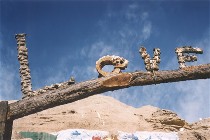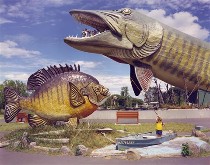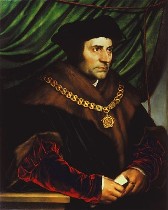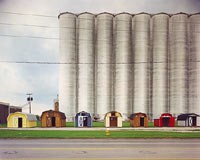 David Graham‘s talk to nearly 50 students at Penn, yesterday, was a “how I found my way in life” charmer, with a list of multiple influences and an artistic agenda that was kinder than I had imagined (right, “Leonard”).
David Graham‘s talk to nearly 50 students at Penn, yesterday, was a “how I found my way in life” charmer, with a list of multiple influences and an artistic agenda that was kinder than I had imagined (right, “Leonard”).Graham, who has a sense of humor about himself and the long road he hoed before he figured out what he was doing, seems to genuinely love the people who he photographs, including the impersonators. I had always assumed that there was a snicker in these photos, but after listening to him talk I had to change my mind.
In Bush’s America there were no images of the common man, he said. The ordinary people he photographs refuse to sacrifice their individuality and innovative sense.
“I celebrate them for their defiance,” he said.
 Graham, who teaches at the University of the Arts, has had a couple of shows at the Institute of Contemporary Art, and lots of freelance gigs for national magazines. His most recent book collection of his photographs is “Declaring Independence.” He also took the photographs for “Philadelphia Murals, and the Stories They Tell” (image, “Fishing Hall of Fame,” a photo influenced by vintage postcards).
Graham, who teaches at the University of the Arts, has had a couple of shows at the Institute of Contemporary Art, and lots of freelance gigs for national magazines. His most recent book collection of his photographs is “Declaring Independence.” He also took the photographs for “Philadelphia Murals, and the Stories They Tell” (image, “Fishing Hall of Fame,” a photo influenced by vintage postcards).

Graham traced his visual education through family snapshots, an art history class–he threw up a slide of Holbein’s Sir Thomas More for its startling descriptive qualities– and vintage picture postcards.
His influences included Ray Metzger, Darius Kinsey, August Sandor, Walker Evans, Weegee, Robert Frank, Diane Arbus, Richard Avedon–it seemed like there wasn’t a photographer out there who hadn’t given Graham some insight, some approach to how to take a picture.
 Graham was modest about his ineptness with lighting, while showing a bunch of pictures with great lighting (image left, “Maumee, OH,” which did not require any help from studio lighting).
Graham was modest about his ineptness with lighting, while showing a bunch of pictures with great lighting (image left, “Maumee, OH,” which did not require any help from studio lighting). He emphasized how surprises in scale and exaggerations (techniques he got from the vintage picture postcards) and triangulation in composition were constants in his work, which is a compendium of roadside America and how people express themselves.
Of photography as a career, he said, “You’re curating the world at large.”









